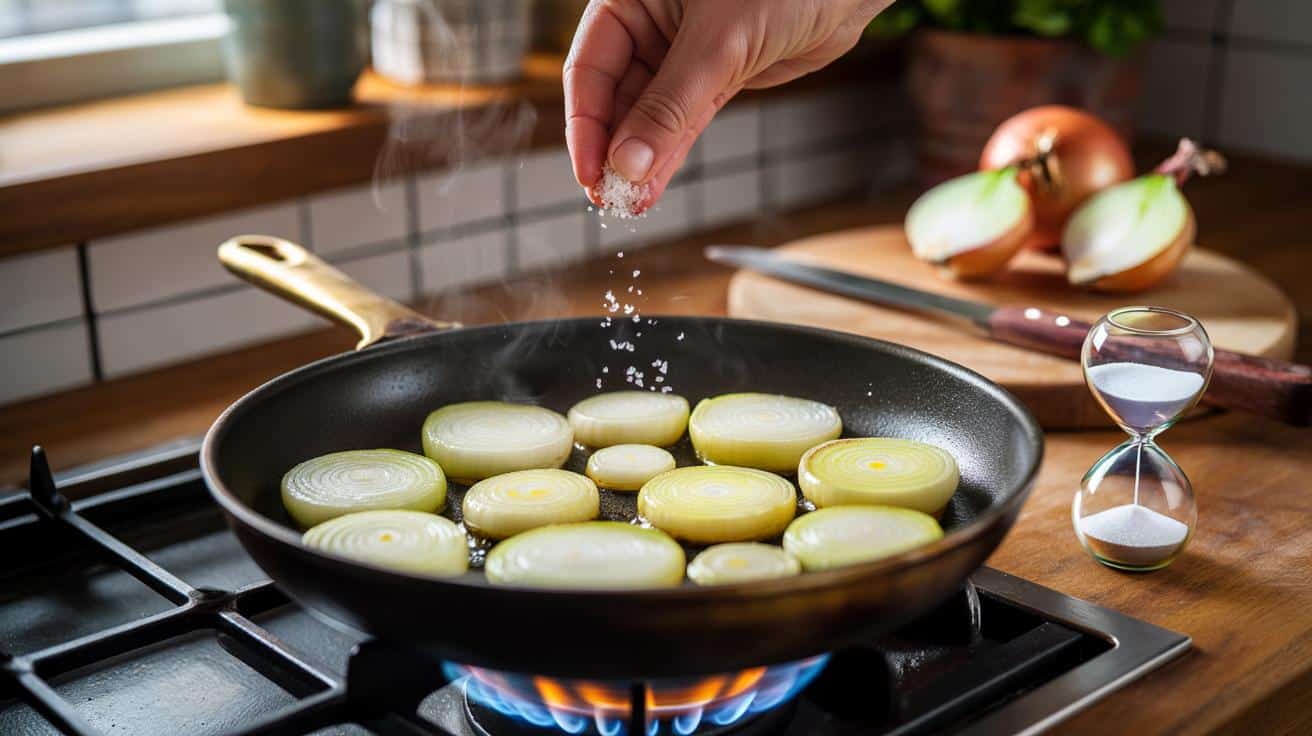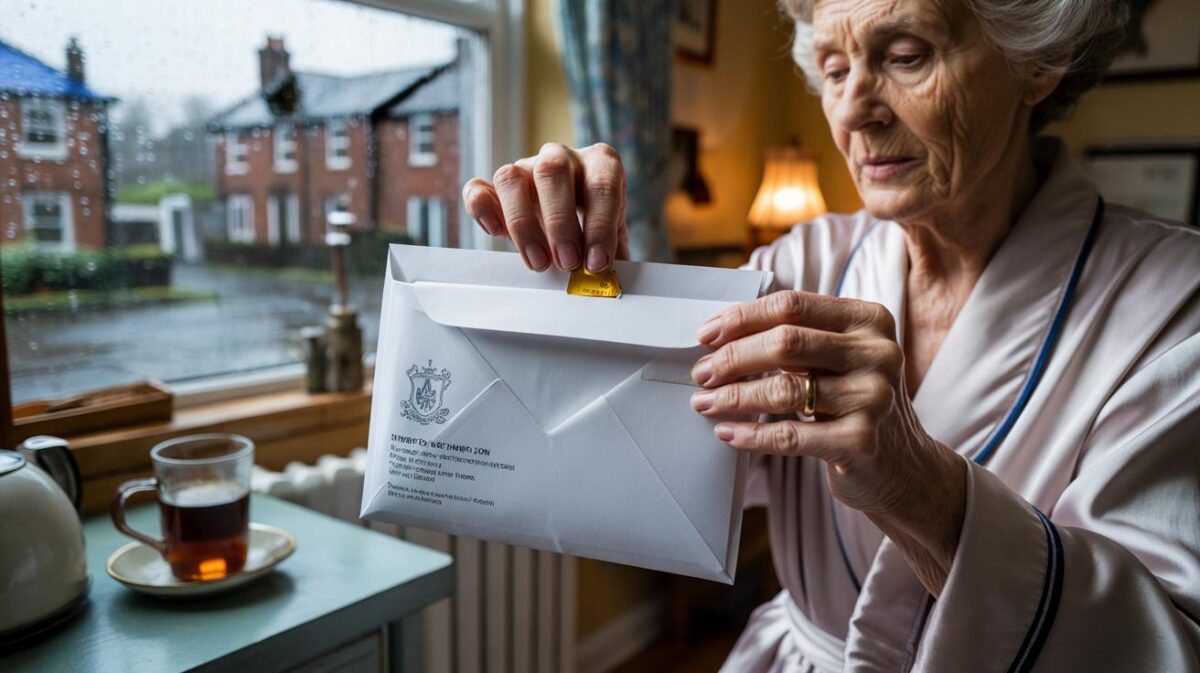A tiny tweak fixes that.
Across home kitchens, one short pause at the start of frying is changing the flavour of onions without fancy kit or costly ingredients. The method is simple, fast and kind to busy cooks who want more sweetness and depth from the same bag of onions.
The 60-second step that changes everything
Start with a dry, heavy pan on medium heat. Add a tablespoon of oil or a knob of butter. Tip in sliced onions. Now perform the step most people skip: sprinkle fine salt right away, spread the onions in an even layer, then leave them untouched for 60 seconds.
Sprinkle salt, spread onions, then do nothing for 60 seconds. That pause builds flavour fast.
This quiet minute pulls moisture to the surface, dissolves sugars and encourages even browning. After that first minute, stir once, then continue cooking, stirring every two to three minutes. Keep the sizzle steady, not harsh. Add a teaspoon of water if edges catch. Let steam escape so the pan stays dry enough to brown.
Why your onions taste flat
Onions carry natural sugars and sharp sulphur compounds. Heat breaks the harshness and frees sweetness. Too much heat scorches surface sugars before the centres soften. Too little heat steams the onions and stalls browning. Crowded pans trap water. Random stirring interrupts browning zones and spreads bitterness from burnt bits.
Salting early solves three of these problems. It draws liquid out quickly, which spreads sugars across the cut surfaces. It softens cell walls so slices slump and make better contact with the pan. It reduces sticking, so you stir less and brown more.
Use 1/4 teaspoon fine salt per large onion at the start; keep to medium heat; stir every 2–3 minutes.
How it works in the pan
That first minute behaves like a primer. The salt drags out water, which briefly simmers. As the water evaporates, surface sugars stay behind and brown evenly. The pan never spikes too hot because the initial moisture buffers the heat. You avoid the bitter leap from pale to burnt.
This controlled start leads to a sweeter profile. In informal tastings, many home cooks reported roughly a third more perceived sweetness, with fewer burnt notes. Texture also improves. Slices soften without collapsing into a jammy tangle unless you cook them much longer for full caramelisation.
Your quick frying checklist
- Slice evenly: 5–6 mm thick for frying, thinner if you want speed.
- Heat medium: steady sizzle, no smoke. Adjust by small nudges.
- Salt early: about 1/4 teaspoon per large onion.
- Pause 60 seconds: no stirring while the salt does its job.
- Stir occasionally: every 2–3 minutes, not constantly.
- Manage moisture: crack the lid or keep the pan open for browning.
- Add water by teaspoons if edges threaten to burn.
- Finish with acid: a splash of vinegar or lemon brightens sweetness.
Three common methods compared
| Method | Heat | Time to golden | Flavour notes | Risk level |
|---|---|---|---|---|
| High heat, constant stirring | High | 4–6 minutes | Patchy browning, bitter edges, raw centres | High |
| Medium heat with 60-second salted pause | Medium | 7–10 minutes | Even sweetness, gentle bite, balanced savoury depth | Low |
| Low and slow caramelise | Low | 30–45 minutes | Jammy, deep caramel, intense sweetness | Low, but time-heavy |
What about tears at the chopping board
Sharp knives help. Clean cuts release fewer irritants. Chill onions for 20 minutes before slicing if you have time. Leave the root end intact until the last chops. Work near the hob with the extractor on to pull fumes away. TV chefs often use these tricks because they work and require no gadgets.
Seasoning and fat choices that boost flavour
Butter brings dairy richness. Oil handles higher heat without burning. A half-and-half mix gives you both. Add a pinch of ground black pepper early to bloom in the fat. Finish with a teaspoon of sherry vinegar or cider vinegar. The acid lifts sweetness and refreshes the palate. A small knob of butter at the end adds gloss.
Speed hacks and pitfalls
A tiny pinch of bicarbonate of soda can speed browning. Use a very small amount, about 1/16 teaspoon per large onion. It raises pH and accelerates the Maillard reaction. Too much turns onions mushy and soapy. If you try it, keep heat modest and watch the pan. You can also slice onions slightly thinner to save a minute or two, though you trade some bite.
Avoid crowding. A pan piled high will steam. Cook in two batches if needed. Use a wider pan for more surface area. Resist the urge to stir constantly. Browning needs contact time. If you see smoke, drop the heat and add a teaspoon of water. Brown bits stuck to the pan are flavour. Loosen them with a splash of water, stock or wine, then scrape gently.
Practical uses for better fried onions
Spoon them over steak or grilled mushrooms. Fold into mashed potatoes with chopped chives. Stir through cooked lentils with a spoon of yoghurt. Layer on a cheese toastie. Add to a quick curry base with ginger and garlic. The 60-second step sets you up for all of these without needing a long caramelise.
Planning, storage and nutrition
Cook a double batch at the weekend. Keep a portion in the fridge for four days. Freeze flat in small bags for a month. Reheat from frozen in a hot pan and refresh with a squeeze of lemon. Onions bring fibre, prebiotics and potassium. Frying in moderate oil keeps them lighter than deep-fried toppings. That early salt means you often need less salt later because flavour runs deeper.
If you want to go further
Try different varieties. Brown onions give strength. Red onions turn rosy, with a soft berry note. Sweet onions caramelise faster but can collapse if sliced too thin. Add spices to the fat at the start. Cumin, fennel seed or mustard seed crackle and perfume the pan. For burgers, cut thick rings and use the same 60-second pause before flipping. For a pasta base, dice small, salt early, and cook to pale gold before adding tomatoes.
Test the step yourself. Fry two small batches side by side. In one pan, add salt at the start and wait 60 seconds. In the other, hold the salt and stir immediately. Taste blind if you can. Most people notice cleaner sweetness, gentler acidity and fewer burnt notes with the salted pause. Small rituals like this help weekday cooking feel controlled and reliable, even when the clock is tight.









Just tried the salted 60‑second pause on a stainless pan—night and day. About a third more sweetness, fewer bitter bits, and I stirred way less. I finished with a splash of cider vinegar as you suggest and it really lifted the flavour. This tiny tweak is going into my weeknight routine; it even seemed to cut the crying when I kept the extractor on. Defintely a keeper.